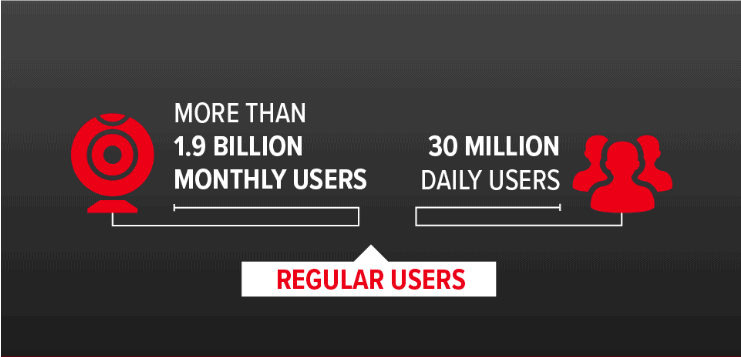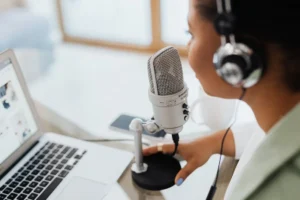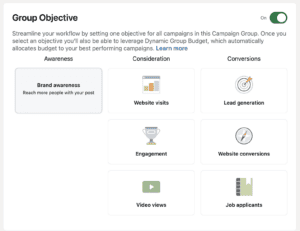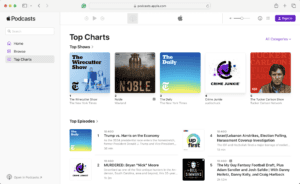You’ve spent time researching, recording, editing, and publishing an engaging podcast episode that your listeners can’t get enough of. Your hard work is paying off, the number of episode listens are increasing but what if there was another way to squeeze even more juice out of the post? Repurposing podcast content is the perfect strategy to refresh existing episodes into new mediums. It can help you discover new audiences and keep your current listeners engaged all by uniquely packaging the content you’ve already created.
Podcasters typically struggle with the pace at which they need to produce new, interesting episodes. By repurposing your podcast content for social media, blog posts, or videos, you’re able to stretch one episode into multiple engaging posts. In the end, it’ll save you time while contributing to your goal of consistently providing your audience engaging content.
In this article, we’ll show you why repurposing your podcast is important followed by five ways to refresh one episode into multiple mediums.
Action
Read to start your own podcast? Learn the nitty-gritty details of starting your own show in our comprehensive guide. Learn how to start a podcast.
Why Is Repurposing My Podcast Content Important?
According to Edison Research, about 32% of Americans have listened to a podcast in the past month. Your current promotional strategy is likely putting your show in front of this pool of listeners but what about the other 68% of the population? Repurposing podcast content for new channels is how you can tap into these new audiences and introduce them to your brand.
While the most important benefit of repurposing podcast content comes down to audience growth and retention, there are a few more reasons why you should get on board.
SEO value
If you decide to repurpose your content into written material, you’ll access previously untapped SEO value. Search engines easily crawl articles and blog posts helping your episode content rank higher in search results. There are also additional opportunities to include internal links to your other written content increasing the authority of the page. As people search for answers related to your topic, you now have a better chance of being discovered and hooking a new listener.
Credibility
You chose your podcast topic because you’re an authority on the subject and have a lot to contribute to the conversation. As you generate new assets, you’ll explain your episode content in multiple ways. This makes it easier for different types of people to understand your key points and see you as an authority in your space. Increasing your credibility is important if podcasting is part of your strategy to become a leader in your industry.
Brand awareness
Famous marketing expert, Dr. Jeffrey Lant, formulated the ‘Rule of Seven’, saying consumers need to see your brand’s messaging a minimum of seven times before taking action. Consistently seeing your content in their feeds or search results will build trust and ultimately attract new listeners to check out your show. Repurposing podcast content for multiple channels is the best way to satisfy this Rule of Seven and increase your audience.
How To Repurpose Podcast Content
Now that we know why repurposing podcast content is important, we need to figure out just how to do it. The best part of this process is you’ve already done the heavy lifting when researching, recording, and publishing the episode so now it’s all about repackaging the information into new ways.
Here are five ways to get you started transforming your podcast content into refreshing assets.
1. Blog posts
You should already have a dedicated website for your podcast so accompanying episodes with blog posts are easy to implement. Outside of show notes, you have a few avenues to further flesh out your audio content. For interviews, transcribe a few of the most interesting questions and answers then have guests add more context. For podcasts based on true stories, transcribe your episode and include photographs or newspaper clippings from the event for interesting visual elements.
Blog posts are an opportunity to add more to the conversation and provide extra value. Build off of your episode’s topic and think about how you can complement what you’ve said with external resources.
Do you currently have a blog and want to start a podcast based on your content? Reverse engineering this process is easy. To pick which pieces are the best fit, first look at the data. Assess which blog pieces have received the most visits and put together a list of your top ten performing articles.
Next think about how you can flesh out the written material for an episode. Going from text to audio offers the opportunity to include emotional elements, more tone, and dramatic effects to enhance the post. Take advantage of the opportunity to appeal your audience’s other senses.
2. Video
YouTube is the second largest search engine, second only to Google, so it’s important to feature your podcast here. Luckily, repurposing a podcast into video content isn’t a lot of heavy lifting.
The easiest way put your episodes on YouTube is to simply upload the audio files with a static image. You can either republish an entire episode or cut it down into digestible clips for your most buzz-worthy sound bites.
If you host your podcast on Castos, repurposing your podcast for YouTube is easy. Each time you publish a new episode, we’ll automatically push it to YouTube’s platform–that’s really all it takes.
You also have the option of featuring bonus video material to offer a behind the scenes look at your recording process. Set up a camera to capture the actual episode recording so listeners can see as well as hear what happened in the studio. This method works especially great if you often feature interviews within your podcast. Think of The Joe Rogan Experience and his set up.
3. Infographics
Infographics are the perfect way to visually explain data-related or complex topics. For podcasters working to become an industry leader, designing infographics can help the audience better grasp the topic and easily distribute your information to their network. It’s difficult to send a colleague a podcast link with instructions on where to find the relevant information. It’s much easier to send along an infographic that encapsulates the major points with the data to back it up.
Repurposing podcast content into these visual elements also works well for hosts who are promoting their business or side hustle. If your product helps solve a need, use an infographic to spell out how much time, money, stress, etc. your customers save. Detail how many happy users you have and include testimonials. Wrapping your episode’s content into an easy to digest graphic can help drive home how useful your products are.
Creating infographics does require a bit of design work but it pays off in the long run. Studies show people are 65% more likely to recall information three days later when paired with an image. Thinking about the ‘Rule of Seven’, your brand will stick in people’s minds well after seeing your visuals.
For more ideas on types of infographics, check out BloggingPro’s tips.
4. Social media posts
You already have dedicated social media channels set up so why not repurpose your podcast content to help promote your show. Turn powerful quotes into aesthetically pleasing imagery or tease episode content with 2 minute clips. Social media platforms are the channels you want to focus on how impactful your visuals are to make people stop in their feeds.
To create cohesive imagery, we recommend creating a template for each asset type. You can easily plug in the new quote, insert the right background, and have each post look on brand every time.
The interactions available across social media also offers a new way to feature guests on your show. After publishing an episode, host a Q&A on your Facebook page where listeners can chime in with their questions. This real-time engagement generates bonus content that can be used to create buzz about your show and attract new users later on.
Check out Headliner to easily make engaging social media posts using video clip and episode sound bites.
5. E-books or courses
Many podcasts focus on educational material to help people learn a new skill or better understand an industry. If this describes your show, you’re in a great position to repurpose your podcast content into an e-book or online course.
Similar to blog posts, you’ll want to add additional information that builds off your episode. Add more value to your course materials rather than just publishing a transcript. Try worksheets, external reference material, and more in-depth explanations of complex topics. E-books and courses are meant to help users master something new so focus highlighting your expertise to a new audience.
How to Repurpose Other Content Into Podcast Episodes
Repurposing content works both wells. Not only can you turn your podcast episodes into other forms of content, you can turn other forms of content into podcast episodes. Your existing content is the perfect foundation for future podcast episodes.
Here are six kinds of content you can use to generate new podcast episodes.
1. Blog articles
Read through one of your blog articles. How long did it take? Probably less than five minutes. Now imagine you turned that topic into a 45 minute or hour-long podcast episode. You could go a lot deeper into the subject. You could include more data and sources. You could quote and respond to influential people. You could go over the same points multiple ways to make sure your audience understands.
People expect to spend more time listening to podcasts than reading a single article, so you can dive deeper into a particular topic. This is especially helpful if you think a topic is complex, requires some emotional context, or requires a lot of backstory that you didn’t include in the original article.
If your article is an interview, invite the interviewee on to your show and have them provide more information on their answers. They would love another opportunity to promote themselves and you get more free content.
2. Stories or fiction
If you write and publish short stories, you can easily turn them into a podcast by simply reading them aloud. You can read them yourself or hire a professional voice actor. It’s also fun to bring friends on your show to read character voices!
Some people prefer audio versions of stories because it helps them understand the author’s intended cadence, intensity, and emotion. Instead of telling them that a character speaks slowly, you could create a deeper experience by reading their dialogue like they would.
For extra value, give your listeners a little context for each story. Explain why you wrote it or if it has any special meaning to you. Let them know when they can expect to hear the next installment.
3. Religious services
If you’re part of a religious organization, record your services and turn them into podcast episodes. Make your episodes available to people who couldn’t attend the service. This a great way to foster your community and keep people engaged.
The best part about this kind of repurposing is that it requires hardly any work at all. You don’t need to do any additional planning. Simply perform the service as you normally would, but capture it with an audio recording.
There’s a real challenge here, however. Depending on where you perform your service, capturing clear audio can be difficult. You can’t always plant a single omnidirectional mic in a room and expect it to capture everything. You may need to attach mics to certain people or instruments. But once you solve this problem, your workload should be minimal.
4. Live presentations
If you give lectures, speeches, or presentations, you know how much work they take to prepare to deliver. You can get more mileage out of that work by turning your presentations into podcast episodes.
The process is even simpler than recording a religious service. Just attach a mic to your shirt while you talk to capture a recording. You may need to add a bit of context to the beginning of each episode (like where you are, why you choose that topic, and who you were speaking too), but that should only take a couple minutes to record.
If you give a presentation for a company or group, read your contract carefully. Some require you to provide a unique presentation that isn’t available anywhere else. Make sure you don’t have this provision before you publish a recording.
5. Webinars
Like live presentations, webinars take a lot of time to prepare, so it’s smart to get as much content out of the performance as possible. Fortunately, webinars already come with an audio track you can release as a podcast episode.
However, the presentation slides are usually a critical component of a webinar. You probably refer to them constantly throughout the presentation.
Break out your favorite podcast editing software to splice in a few bits of context here and there. For instance, if your webinar recording says “check out the graph on slide 18 to see my point,” you may want to add a line to your podcast that describes the graph so the listener who can’t see the slide understands.
It’s also a good idea to publish your slides within your podcast show notes on your podcast website.
6. Social media posts
You probably have experience turning your podcast content into social media posts, but you can do it the other way as well. This takes more work than most of the other options on this list, but it’s a powerful way to generate content.
Look for social media posts that have a lot of traction with your fans. Posts with a lot of likes, shares, and retweets are good, but posts with lots of comments are better. A post that enticed a lot of people to comment means it resonated with your audience.
Comb through the comments to understand how your audience feels about the topic. Do they need more information? Do you need to correct some bad information? Do they have a strong emotional connection to the topic?
Use the topic of that social media post as a starting point for your next podcast episode. Respond to their comments and answer their questions. Most importantly, make it clear that you chose the topic because they care about it.
Summary
Finding new ways to squeeze even more value out of your amazing episodes is one part to creating engaging content. Repurposing podcast content across these five mediums will help you discover new audiences and further interact with your current fan base.
As you build out your strategy, it’s important to remember not to just create a replica of the episode and call it day. Add additional value, context, information, or visual elements to encourage your following to consume both the episode and additional posts. Make the assets cohesive with consistent messaging but be sure to update them for each specific channel. In the end, you’ll have a well-rounded content mix for every episode.



